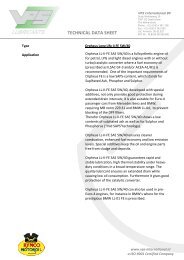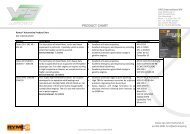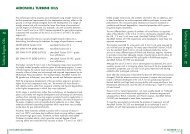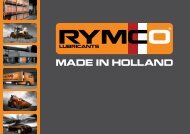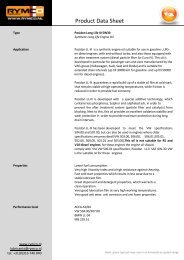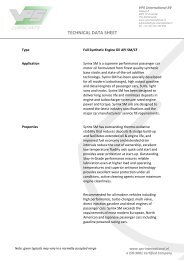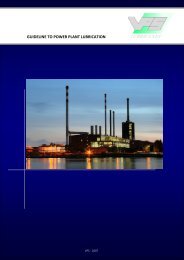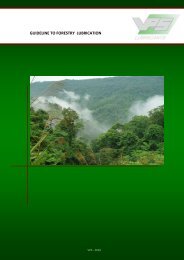AvBook Intro/notes A/W Sect1 - Shell
AvBook Intro/notes A/W Sect1 - Shell
AvBook Intro/notes A/W Sect1 - Shell
Create successful ePaper yourself
Turn your PDF publications into a flip-book with our unique Google optimized e-Paper software.
Elastomer/ Mineral Oil Based Synthetic Hydro-Plastic Hydraulic Fluids carbon BasedHydraulic FluidsFlurocarbon (Viton) Very Good Very GoodAcrylonitrile Good GoodPolyester Good GoodSilicone Poor to Good Poor to GoodTeflon Very Good Very GoodNylon Poor to Good Poor to GoodThe latest issues of MIL-PRF-5606, MIL-PRF-6083, MIL-PRF-46170, MIL-PRF-83282 and MIL-PRF-87257 require hydraulic fluids to be "Superclean". Bysuperclean it is meant that there is a very tight control on particulates in thefluid. Over the years hydraulic systems and components have been reducedin size and operating pressures have increased with the result thatparticulates in the hydraulic fluid can cause system failures throughblocking nozzles and pipes or through erosion (for example particulateshitting metal surface and eroding it away) and/or wear. Thus thesespecifications include very tight limits on particulates and typically for MIL-PRF-5606H, MIL-PRF-83282D and MIL-PRF-87257A the requirement is ofthe order:184Hydraulic FluidsBuna-S Poor PoorPerbunan Good GoodMethacrylate Good GoodNeoprene Fair to Good Fair to GoodNatural Rubber Poor to Fair Poor to FairPolyethylene Good GoodButyl Rubber Very Poor to Poor Very Poor to PoorPoly Vinyl Chloride Poor to Good Poor to GoodCompatibility Rating:Very Good – Good – Fair – Poor – Very PoorTYPES OF HYDRAULIC FLUIDSMineral Synthetic Hydrocarbon Phosphate EsterAero<strong>Shell</strong> Fluid 4 Aero<strong>Shell</strong> Fluid 31 Skydrol 500B4Aero<strong>Shell</strong> Fluid 41 Aero<strong>Shell</strong> Fluid 51 Skydrol LD4Aero<strong>Shell</strong> Fluid 71 Aero<strong>Shell</strong> Fluid 61Aero<strong>Shell</strong> Fluid SSFAero<strong>Shell</strong> Fluid LGFParticle Size Microscopic Count Automatic Count5 to 15 µm 2,500 10,00016 to 25 µm 1,000 1,00026 to 50 µm 250 15051 to 100 µm 25 20over 100 µm 10 5MIL-PRF-5606H allows automatic method onlyMIL-PRF-83282D allows both methodsMIL-PRF-87257A allows automatic method only<strong>Shell</strong> manufacturing plants when manufacturing these fluids go toconsiderable effort to meet these stringent limits, this includes multistagefiltration, pre-cleaning of containers immediately before filling andpackaging the fluid in 'clean room' conditions.However, it is pointless for <strong>Shell</strong> manufacturing plants to go to theseextreme lengths if operators themselves do not handle the fluid correctly inorder to ensure that the superclean properties are maintained andenhanced.Thus it is recommended that operators take extreme care by:- never opening containers to atmosphere- using containers of correct size- using a dispensing device which includes fine filtration- ensuring hydraulic system is clean and free from metal particles,dust, dirt and other contaminants- periodically connecting the aircraft hydraulic system to groundhydraulic trolley and circulating fluid through fine filtration.Hydraulic Fluids185HYDRAULIC FLUID CLEANLINESS - SUPERCLEAN PROPERTIESHydraulic fluid users should be keen to ensure optimum performance ofhydraulic equipment and extend equipment life. One way of achieving thisis by reducing wear of hydraulic system components. There are many waysin which wear can occur but one of the most common is due to particulatesin the hydraulic fluid.www.shell.com/aviationThe Aero<strong>Shell</strong> BookEdition 18 2003
AEROSHELL FLUID 41194Hydraulic FluidsAero<strong>Shell</strong> Fluid 41 is a mineral hydraulic oil manufactured to a very highlevel of cleanliness, and possesses improved fluid properties. Aero<strong>Shell</strong>Fluid 41 contains additives which provide excellent low temperature fluidityas well as exceptional anti-wear, oxidation - corrosion inhibition and shearstability. In addition metal de-activators and foam inhibitors are included inthis high viscosity index fluid to enhance performance in hydraulicapplications. Aero<strong>Shell</strong> Fluid 41 is capable of wide temperature rangeoperation.Aero<strong>Shell</strong> Fluid 41 is dyed red.APPLICATIONSAero<strong>Shell</strong> Fluid 41 is intended as a hydraulic fluid in all modern aircraftapplications requiring a mineral hydraulic fluid. Aero<strong>Shell</strong> Fluid 41 isparticularly recommended where use of a "superclean" fluid can contributeto improvements in component reliability, and can be used in aircraftsystems operating unpressurised between –54°C to 90°C and pressurisedbetween –54°C to 135°C.Aero<strong>Shell</strong> Fluid 41 should be used in systems with synthetic rubbercomponents and must not be used in systems incorporating natural rubber.Refer to the General Notes at the front of this section for furtherinformation.Aero<strong>Shell</strong> Fluid 41 is compatible with Aero<strong>Shell</strong> Fluids 4, 31, 51, 61 and71 and SSF/LGF.Chlorinated solvents should not be used for cleaning hydraulic componentswhich use Aero<strong>Shell</strong> Fluid 41. The residual solvent contaminates thehydraulic fluid and may lead to corrosion.SPECIFICATIONSU.S.BritishApproved MIL-PRF-5606H*(both U.S. and European production)Approved DEF STAN 91-48 GradeSuperclean* (European productiononly)Meets DEF STAN 91-48 GradeNormal (European production only)Equivalent to DEF STAN 91-48Grades Superclean* & Normal(U.S. production only)French Approved DCSEA 415/ARussianNATO CodeJoint Service Designation*Superclean gradesAnalogue to AMG-10H-515* (equivalent H-520)OM-15* (equivalent OM-18)The British specification DEF STAN 91-48 covers two grades (normal andsuperclean) of mineral hydraulic fluid which differ only in their cleanlinesslimits. Aero<strong>Shell</strong> Fluid 41 is manufactured to meet the supercleanrequirements and thus it also meets the requirements of the normal grade.Hydraulic Fluids195www.shell.com/aviationThe Aero<strong>Shell</strong> BookEdition 18 2003
PROPERTIES MIL-PRF-5606H TYPICALPROPERTIES MIL-PRF-5606H TYPICALU.S.ProductionEuropeanProductionU.S.ProductionEuropeanProductionOil type Mineral Mineral MineralCopper corrosion 2e max lb 2b196Hydraulic FluidsKinematic viscositymm 2 /s@ 100°C 4.90 min 6.13 5.30@ 40°C 13.2 min 15.68 14.1@ –40°C 600 max 384 491@ –54°C 2500 max 1450 2300Viscosity index – 214 Over 200Flashpoint, PenskyMartin closed cup °C 82 min 104 105Autoignitiontemperature °C – 230 230Pourpoint °C –60 max
AEROSHELL FLUID 51Aero<strong>Shell</strong> Fluid 51 is a synthetic hydrocarbon and ester based fluid for usein hydraulic systems which require reliable operation in extreme low andhigh temperatures as well as performance outside the capability oftraditional MIL-PRF-5606 mineral based fluids.Aero<strong>Shell</strong> Fluid 51 is formulated with high technology additives to provideoxidation and corrosion resistance, anti-wear, and anti-foaming protection.Aero<strong>Shell</strong> Fluid 51 is superclean filtered to ensure optimum performance inparticulate monitored systems.Aero<strong>Shell</strong> Fluid 51 is dyed red.The useful operating temperature range is –54°C to +135°C.PROPERTIES MIL-PRF-87257A TYPICALOil Type – SyntheticHydrocarbon198Hydraulic FluidsAPPLICATIONSAero<strong>Shell</strong> Fluid 51 is recommended for use in aircraft, ordnance andmissile systems operating from –54°C to +135°C. This fluid should beconsidered for use in auto pilots, shock absorbers, brakes, flight controlsystems, hydraulic servo-control systems and other systems using syntheticelastomer seals. This fluid is especially recommended for use in highaltitude aircraft that normally operate with extended loiter times and highendurance levels such as UAVs and ELINT systems.Aero<strong>Shell</strong> Fluid 51 is a synthetic hydrocarbon oil and should not be used incontact with incompatible seal materials. Refer to the General Notes at thefront of this section for further information.Aero<strong>Shell</strong> Fluid 51 is compatible with Aero<strong>Shell</strong> Fluids 4, 31, 41, 61 and71 and can be used in systems designed to operate with MIL-PRF-5606,MIL-PRF-6083, MIL-PRF-83282 and MIL-PRF-46170 fluids.Chlorinated solvents should not be used for cleaning hydraulic componentswhich use Aero<strong>Shell</strong> Fluid 51. The residual solvent contaminates thehydraulic fluid and may lead to corrosion.SPECIFICATIONSU.S.BritishFrench –Russian –Approved MIL-PRF-87257A(MIL-PRF-87257A)Kinematic viscosity mm 2 /s@ 100°C 2.0 min 2.12@ 40°C 6.7 min 6.80@ –40°C 550 max 440@ –54°C 2500 max 1945Flashpoint °C 160 min 175Fire Point °C 170 min 185Total Acidity mgKOH/g 0.20 max 0.00Evaporation loss 6.5 hrs@150°C % m 20 max 13.5Relative density @ 15.6/15.6°C Report 0.838Pourpoint °C –60 max –65Low temperature stability72 hrs @ −54°C Must pass PassesHigh temperature stability– change in viscosity @ 40°C % 5 max Less than 5– change in acidity 0.1 max Less than 0.1Gravimetric Filtration, mg/100ml 0.3 max 0.12Filtration time minutes 15 max 12Particle Count, Automatic, per Lt5 to 15 µm 10000 max 240016 to 25 µm 1000 max 25026 to 50 µm 150 max 9051 to 100 µm 20 max 5Over 100 µm 5 max 0Table continuedHydraulic Fluids199NATO Code H-538Joint Service DesignationOX-538www.shell.com/aviationThe Aero<strong>Shell</strong> BookEdition 18 2003
NOTES200Hydraulic FluidsTable continuedPROPERTIES MIL-PRF-87257A TYPICALWater content ppm 100 max 65Foam resistance ASTM Seq 1 65 ml max 20Flame propagation cm/s 0.40 max ConformsRubber swell, NBR-L % 19 to 30 234-Ball Wear, 75°C - scar dia, mm1 kg load 0.21 max 0.1710 kg load 0.30 max 0.2240 kg load 0.65 max 0.52Chlorine content ppm 50 max Less than 50Flammability Must pass PassesOxidation & corrosion stability– metal weight change Must pass Passes– viscosity change % 10 max Less than 10– change in acidity mgKOH/g 0.2 max Less than 0.02Hydraulic Fluids201www.shell.com/aviationThe Aero<strong>Shell</strong> BookEdition 18 2003
AEROSHELL FLUID 61202Hydraulic FluidsAero<strong>Shell</strong> Fluid 61 is a synthetic hydrocarbon base hydraulic fluidspecifically inhibited to provide excellent oxidation stability for the oil andgood corrosion preventive protection to the hydraulic system.APPLICATIONSAero<strong>Shell</strong> Fluid 61 is designed for use where a fire resistant preservativegrade hydraulic fluid is required and is suitable for operational use as wellas preservation of components during storage and shipment.Aero<strong>Shell</strong> Fluid 61 has an operating temperature range of –40°C to+204°C.Aero<strong>Shell</strong> Fluid 61 is compatible with Aero<strong>Shell</strong> Fluids 4, 31, 41, 51 and71.Aero<strong>Shell</strong> Fluid 61 is a synthetic oil and should not be used in contact withincompatible seal materials. Refer to the General Notes at the front of thissection for further information.Chlorinated solvents should not be used for cleaning hydraulic componentswhich use Aero<strong>Shell</strong> Fluid 61. The residual solvent contaminates thehydraulic fluid and may lead to corrosion.SPECIFICATIONSU.S. Approved MIL-PRF-46170C Type I*PROPERTIES MIL-PRF-46170C TYPICALType IOil Type – SyntheticHydrocarbonKinematic viscosity mm 2 /s@ 100°C 3.4 min 3.71@ 40°C 19.5 max 15.43@ –40°C 2600 max 2488@ –54°C Report 15022FlashpointCleveland Open cup °C 218 min 233Fire PointCleveland Open Cup °C 246 min 248Acid or Base number mgKOH/g 0.2 max 0.07Evaporation loss 22 hrs@149°C % m 5.0 max 2.39Relative density @ 15.6/15.6°C – 0.859Hydraulic Fluids203British –Pourpoint °C –54 max Below –54French –Water Content ppm 500 max 278Russian –Auto-ignition temperature °C 343 min 354NATO Code H-544Colour Undyed UndyedJoint Service Designation –*The US specification covers two grades, Type I and Type II. The onlydifference between the two grades is that Type II is dyed red for aerospaceuse whereas Type I is undyed.Particle Count, Automatic, per Lt5 to 25 µm 10000 max 141426 to 50 µm 250 max 3951 to 100 µm 50 max 4Over100 µm 10 max 0Table continuedwww.shell.com/aviationThe Aero<strong>Shell</strong> BookEdition 18 2003
NOTES204Hydraulic FluidsTable continuedPROPERTIES MIL-PRF-46170C TYPICALType ITrace sediment mg/l 0.005 max 0.001Rubber swell,168 hrs @ 70°C % swell 15 to 25 21.54-Ball Wear, 75°C scar dia, mm10 kg load/1200 rpm 0.3 max 0.2340 kg load/1200 rpm 0.65 max 0.38Galvanic corrosion Must pass PassesOxidation & corrosion stability168 hrs @ 121°C– metal weight change Must pass Passes– viscosity change @ 40°C % 10 max Less than 10– change in acidity mgKOH/g 0.3 max Less than 0.3Low temperature stability Must pass PassesRust prevention Must pass PassesFlammability Must pass PassesHydraulic Fluids205A viscosity/temperature curve is shown at the end of this section.www.shell.com/aviationThe Aero<strong>Shell</strong> BookEdition 18 2003
AEROSHELL FLUID 71Aero<strong>Shell</strong> Fluid 71 is a preservative mineral hydraulic fluid of improvedcleanliness. Aero<strong>Shell</strong> Fluid 71 is composed of a mineral base oil with anadditive package which results in a product with excellent corrosionpreventative properties as well as excellent oxidation stability, and goodanti-wear characteristics.Aero<strong>Shell</strong> Fluid 71 is dyed red.The useful operating temperature range is –54°C to +121°C.PROPERTIES MIL-PRF-6083F TYPICALOil type Mineral MineralKinematic viscosity mm 2 /s@ –40°C 800 max 525@ –54°C 3500 max 2400@ 40°C 13 min 14.3206Hydraulic FluidsAPPLICATIONSAero<strong>Shell</strong> Fluid 71 is intended for preserving hydraulic equipment instorage and also for use in rig testing of hydraulic components.Aero<strong>Shell</strong> Fluid 71 should only be used in hydraulic systems employingsynthetic rubber seals suitable for MIL-PRF-5606/DEF STAN 91-48(Aero<strong>Shell</strong> Fluids 4 or 41) type of fluids. Refer to General Notes at the frontof this section for further information.Aero<strong>Shell</strong> Fluid 71 is compatible with Aero<strong>Shell</strong> Fluids 4, 31, 41, 51 and61.Chlorinated solvents should not be used for cleaning hydraulic componentswhich use Aero<strong>Shell</strong> Fluid 71. The residual solvent contaminates thehydraulic fluid and may lead to corrosion.SPECIFICATIONSU.S.Approved MIL-PRF-6083FBritish Equivalent DEF STAN 80-142FlashpointPensky Martin Closed Cup °C 82 min 88Total Acidity mgKOH/g 0.2 max 0.12Pourpoint °C –59 max Below –59Relative density @ 15.6/15.6°C – 0.879Water content ppm 500 200Colour Red RedTrace sediment mg/l 0.005 max 0.002Oxidation & corrosion stability168 hrs @ 121°C– metal weight change Must pass Passes– viscosity change @ 40°C –5 to +20 Passes– acid number changemgKOH/g 0.2 max Less than 0.2Hydraulic Fluids207French Equivalent to DCSEA 535/ACopper corrosion 3a max PassesRussian –Corrosion inhibition Must pass PassesNATO Code C-635Joint Service DesignationEquivalent PX-26Table continuedwww.shell.com/aviationThe Aero<strong>Shell</strong> BookEdition 18 2003
NOTES208Hydraulic FluidsTable continuedPROPERTIES MIL-PRF-6083F TYPICALParticle Size per 100 ml5 to 25 µm 10000 max 117026 to 50 µm 250 max 9051 to 100 µm 50 max 10Over 100 µm 10 max 1Low temperature stability72 hrs @ –54°C Must pass PassesShear stabilitychange in viscosity @ 40°C % 2.0 max 0.06Rubber swell L rubber % 19 to 28 23Evaporation loss 22 hrs@ 100°C %m 75 max 62Foaming tendency Must pass PassesSteel on steel wear,wear scar diam, mm 1.0 max PassesGravimetric filtration mg/100ml 0.5 max Less than 0.5filtration time mins 15 max 12Hydraulic Fluids209A viscosity/temperature curve is shown at the end of this section.www.shell.com/aviationThe Aero<strong>Shell</strong> BookEdition 18 2003
AEROSHELL SSF AND LGF210Hydraulic FluidsAero<strong>Shell</strong> Shock Strut Fluid (SSF) and Aero<strong>Shell</strong> Landing Gear Fluid (LGF)are mineral hydraulic fluids (MIL-PRF-6083 and MIL-PRF-5606 respectively)to which additional additives have been added to improve the extremepressure characteristics and the fluid’s natural lubricity. The lubricity agentprovides a stable thin film layer to the metal surfaces at mild operatingconditions. When severe conditions exist (landing/touchdown), the extremepressure additive supplies the load carrying needed at the metal-to-metalsurfaces to prevent the occurrence of such phenomena as "ladder cracking"and "slip stiction" of the piston component of the landing gear.Aero<strong>Shell</strong> SSF is Aero<strong>Shell</strong> Fluid 71 plus additives.Aero<strong>Shell</strong> LGF is Aero<strong>Shell</strong> Fluid 41 plus additives.APPLICATIONSAero<strong>Shell</strong> SSF is recommended for all normal applications whilst the betterlow temperature properties of Aero<strong>Shell</strong> LGF make it particularly suitable inareas of low temperature operations.Aero<strong>Shell</strong> SSF and Aero<strong>Shell</strong> LGF are compatible with each other as wellas with Aero<strong>Shell</strong> Fluids 4, 41 and 71.Aero<strong>Shell</strong> SSF and LGF are straw yellow in colour.SPECIFICATIONSU.S. –British –EQUIPMENT MANUFACTURERS APPROVALSAero<strong>Shell</strong> SSF and LGF are approved for use in the shock struts of thefollowing aircraft:BoeingLockheedMcDonnell DouglasAirbus707/720, 727, 737, 747 (exceptthose using BMS 3-11 fluids),757, 767 and 777L1011 TristarDC-8, DC-9, DC-10, MD-80, MD-11CML Code 02-004A (SSF)For use in the landing gear shock struts of other aircraft, operators mustcheck with the respective manufacturer first.PROPERTIES SSF LGFTYPICALTYPICALBase hydraulic fluid specification MIL-PRF-6083F MIL-PRF-5606HKinematic viscosity mm 2 /s@ 40°C 14.5 14.5@ –40°C 560 423@ –54°C 2640 1780Hydraulic Fluids211French –Flashpoint °C 108 110Russian –NATO Code –Neutralisation NumbermgKOH/g 2.6 2.4Joint Service Designation –BoeingApproved BMS 3-32A (Aero<strong>Shell</strong>SSF is approved to Type I andAero<strong>Shell</strong> LGF is approved toType II)Evaporation %SSF 22 hrs @ 99°C 65 –LGF 6 hrs @ 71°C – 18.0McDonnell DouglasApproved DPM-6177Aero<strong>Shell</strong> SSF and LGF are not covered by any military specification.www.shell.com/aviationThe Aero<strong>Shell</strong> BookEdition 18 2003
TYPICAL TEMPERATURE/VISCOSITY CURVEOF AEROSHELL HYDRAULIC FLUIDS212Hydraulic FluidsTable continuedPROPERTIES SSF LGFTYPICALTYPICALRelative density @ 15.6/15.6°C 0.882 0.874Pourpoint °C –62 Below –68FoamingSeq I Foam/Collapse time sec 30/30 45Seq II Foam/Collapse time sec 20/10 –Seq III Foam/Collapse time sec 30/30 –Corrosion – Oxidation Stability(121°C/168 hrs)Metal Weight Change mg/cm 2Copper +0.002 –0.06Aluminium 0 –0.005Steel 0 –0.02Magnesium +0.002 +0.01Cadmium 0 +0.01Fluid PropertiesChange in viscosity % +15 +10.5Change in Acid NumbermgKOH/g +0.5 +0.05Insolubles 1.0mg/100ml Clear4-ball wear, scar diam. mm 0.43 0.43Colour Yellow Yellow4 & 4171Aero<strong>Shell</strong> Fluids31 & 61345710152550100200500Hydraulic Fluids2131000300010000-40-30-20-100102030405060708090100110120130Kinematic viscosity: mm 2 /sTemperature: 0 Cwww.shell.com/aviationThe Aero<strong>Shell</strong> BookEdition 18 2003



